 |
Picks is a monthly sampling of Japan's art scene, offering commentary by a variety of reviewers about exhibitions at museums and galleries in recent weeks, with an emphasis on contemporary art by young artists.
Note: With the lifting of Japan's state of emergency on 25 May, most museums in the country have reopened or are scheduled to reopen by early June, and exhibitions that were interrupted by closures are being extended. However, conditions vary from venue to venue, so please contact any museum you plan to visit in advance. |
 |
 |
|
|
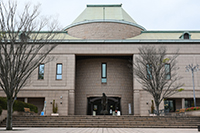 |
 |
| History and Culture Road, Kagoshima |
| - |
Kagoshima City Museum of Art, etc.
(Kagoshima) |
 |
| A stroll down History and Culture Road, a pedestrian course alongside the moat of Tsurumaru Castle in downtown Kagoshima, takes you past a number of impressive buildings with diverse architectural pedigrees. The City Hall (1937) and Central Community Hall (1927) are modernist prewar structures, while the neighborhood's numerous museums boast more contemporary designs. The
Kagoshima City Museum of Art (1985) is a rather stolid, very symmetric postmodernist building with a bit of classical flavor. On a recent visit this reviewer was happy to find the permanent collection there open for viewing, even if the scheduled special exhibitions were still on hold.
|
|
|
 |
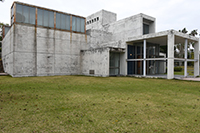 |
 |
| Fumihiko Maki: Iwasaki Art Museum |
| - |
Iwasaki Art Museum
(Kagoshima) |
 |
| At the tip of Kyushu's Satsuma Peninsula, an hour and a half south of Kagoshima by train, one finds the resort town of Ibusuki and the Ibusuki Iwasaki Hotel. On the hotel grounds is the Iwasaki Art Museum, a small facility housing the tasteful collection of resort developer Yohachiro Iwasaki. The real draw, however, is the building itself, completed in 1983. Designed by the legendary architect Fumihiko Maki (b. 1928), it is no exaggeration to call this one of his finest works. The raw concrete façade is stained and weathered, but the interior spaces and details are exquisite, more than acing the test of time. |
|
|

|
 |
 |
|
 |
 |
 |
| Aburatsu Shopping Street |
| - |
Aburatsu Station area
(Miyazaki) |
 |
| The harbor town of Aburatsu -- part of Nichinan City in southern Kyushu -- is best known for hosting the spring training camp of the Hiroshima Carp, one of Japan's most beloved pro ball teams. Though many of the shops around Aburatsu Station are shuttered, the town is visibly thriving more than its neighbors these days. A campaign to revitalize the shopping district has moved new tenants into the shuttered storefronts, among them a cafe, an IT office space, a guest house, a community music salon, and Aburatsu Garden, a minimall of shops occupying revamped shipping containers.
|
|
|
|
|
|
|
|

|
 |
 |
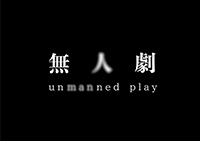 |
 |
| Satoshi Ago: Unmanned Play |
| 29 April 2020 |
Theatre E9 Kyoto
(Kyoto) |
 |
| More a concept than a performance, this presentation was described as a "play with no performers, no staff, no reception, and no audience." Those wishing to attend were instructed as follows: "At the start time, please take a big breath at the place where you are at that time." In other words, focus your mind in a space and time of nothingness. It was not unlike a call to silent prayer, a collective act of faith and solidarity among people isolated in their respective places. |
|
|
 |
 |
| Kengo Kuma: Atami Kaihourou |
| - |
Atami Kaihourou
(Shizuoka) |
 |
| "Water/Glass," a guesthouse designed in 1995 by the now-ubiquitous architect Kengo Kuma, perches on a hill overlooking Sagami Bay in the hot-spring town of Atami. Recently it was converted into a very small (four-room), very pricey luxury resort. Atami Kaihourou is arguably worth the cost of admission for its gorgeous layout and stunning views, but it's also historic in the sense of being the first work in which Kuma employed his trademark louvers. It might even be thought of as the starting point for his rise to prominence in the 21st century. |
|

|
 |
 |
 |
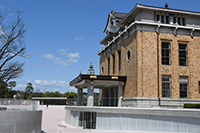 |
 |
Kyoto City Kyocera Museum of Art |
- |
Kyoto City Kyocera Museum of Art
(Kyoto) |
 |
| Kyoto's flagship museum reopened just this year with a new look, courtesy of architects Jun Aoki and Tezzo Nishizawa, and a new name reflecting Kyocera Corporation's acquisition of naming rights in exchange for helping fund the overhaul. The designers gave props to the former Kyoto City Museum, which opened in 1933, by preserving its façade virtually intact. However, they also dug a gently sloping promenade below ground level which guides visitors to a new "Glass Ribbon"- enclosed entrance beneath the old one. Inside, a stairway leads up to the vast Central Hall, to which they have discreetly added
a spiral staircase, a balcony, and an elevator. |
|
|
 |
 |
 |
| Nobeoka Station Multipurpose Facility "encross" |
| - |
JR Nobeoka Station
(Miyazaki) |
 |
| Recent years have seen a proliferation of intriguing projects in and around train stations in Japan's regional cities. Unlike the fashion conceits of Tokyo's bustling transport hubs, such efforts seem spurred by a sense of crisis in these locales. Architect Kumiko Inui's design of encross, a community space connected to the JR terminal in the midsize Kyushu city of Nobeoka, reflects her research into similar programs. There is nothing flamboyant about the structure; rather, it functions as an extension of the older terminal, as well as harmonizing with the many Showa-modernist buildings around the station plaza. |
|
|
|
|
|
|
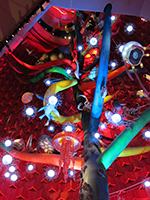 |
 |
| Taro Okamoto: Tower of the Sun |
| - |
Tower of the Sun Museum
(Osaka) |
 |
| The centerpiece of the 1970 Osaka Expo, Okamoto's celebrated tower underwent renovations and earthquake proofing in 2016, reopening to the public in 2018 on a reservations-only basis. Visitors enter the tower from the rear, paying respects to the "Underground Sun" that greets them inside. The old escalator has been removed, so one climbs the stairs up the Tree of Life, festooned with organisms that appear in evolutionary sequence. The psychedelic colors and lighting give the installation a definite seventies vibe. One half expects to see Ultraman, the era's iconic superhero, emerge to fight the giant amoeba and heliozoa.
|
|
 |
|
|
|
 |
|